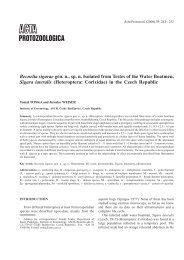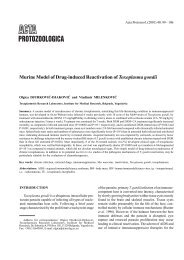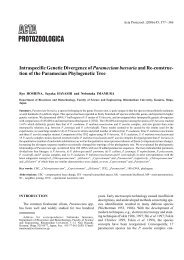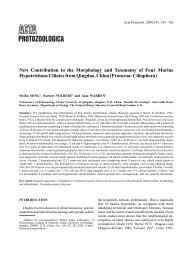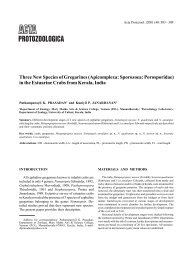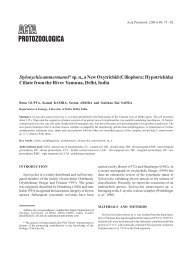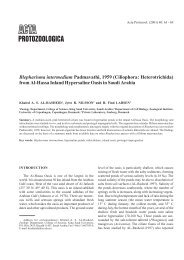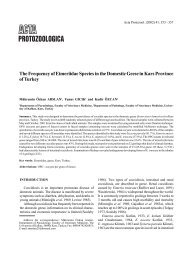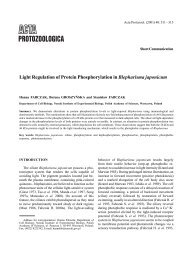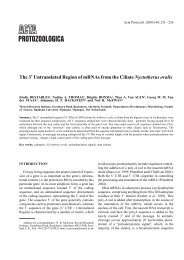Two Eimerian Coccidia (Apicomplexa: Eimeriidae) from the Critically ...
Two Eimerian Coccidia (Apicomplexa: Eimeriidae) from the Critically ...
Two Eimerian Coccidia (Apicomplexa: Eimeriidae) from the Critically ...
- No tags were found...
You also want an ePaper? Increase the reach of your titles
YUMPU automatically turns print PDFs into web optimized ePapers that Google loves.
<strong>Two</strong> Eimeria spp. <strong>from</strong> Heosemys depressa 185Fig. 7. Composite line drawing of sporulated oocyst of Eimeriaarakanensis n. sp. Scale bar: 10 µm.single-layered, colourless, smooth and ~ 0.6 thick. Micropyleand polar granule absent. Globular oocyst residuumcomposed of fine granules present, measuringapproximately 10 - 15 in diameter. Sporocysts ellipsoidalto oval, 12.8 (12-15) × 7 (6-8), sporocyst SI 1.84 (1.63-2.17), with smooth, colourless and less than 0.5 thicksporocyst wall. Stieda body present, knob-like, ~ 1 highand 1-2 wide (n = 12). Substieda body homogenous, subglobular,1-1.5 high and 1.5-2 wide (n = 12). Very thin,membranous, cap-like structure over-layering Stieda body.Sporocyst residuum present as small granules of irregularsizes usually scattered in high number among sporozoites.Sporozoites elongate, cucumber-shaped, lyinghead to tail within sporocyst. Each sporozoite bears onesub-spherical to spherical refractile body (~1-2 × 1.5-2)at one end, smaller nucleus (~1-2 in diameter) locatedsub-centrally.Type host: Arakan forest turtle, Heosemys depressa(Anderson, 1875) (Reptilia: Testudines: Geoemydidae).Type material: Photosyntypes are deposited at <strong>the</strong>Department of Parasitology, University of Veterinaryand Pharmaceutical Sciences Brno, Czech Republic,under collection number R 100/05.Type locality: Western Myanmar (Burma), detailedlocality unknown.Prevalence: Three of nine examined specimens ofH. depressa were infected.Sporulation: Exogenous. Oocyst became fully sporulatedwithin 3-5 days at 20-23°C.Table 1. Review of turtle species reported to date as hosts of Eimeria mitraria (Laveran et Mesnil, 1902), asterisk marks <strong>the</strong> type host.Host Locality Size of oocysts ReferencesGeoemydidae Theobald, 1868Chinemys reevesii (Gray, 1831)* Asia 15 × 10 Laveran and Mesnil (1902)Heosemys depressa (Anderson, 1875) Myanmar 14.9 × 10.1 This studyEmydidae Rafinesque, 1815Chrysemys picta bellii (Gray, 1831) Iowa (USA) 10-15 × 5-11 Deeds and Jahn (1939)Iowa (USA) 10 × 7.6 Wacha and Christiansen (1976)Emydoidea blandingii (Holbrook, 1838) Iowa (USA) Not given Wacha and Christiansen (1980)Emys orbicularis (Linnaeus, 1758) Galicia (Spain) 12.1 × 9.5 (10-14 × 7-11) Segade et al. (2004)Graptemys geographica (Le Seur, 1817) Iowa (USA) 11 × 8.3 Wacha and Christiansen (1976)Graptemys pseudogeographica (Gray, 1831) Iowa (USA) 9.2 × 8.1 Wacha and Christiansen (1976)Graptemys versa Stejneger, 1925 Texas (USA) Not given McAllister et al. (1991)Pseudemys texana Baur, 1893 10 × 8 (8-12 × 6-9) McAllister and Upton (1989)Trachemys scripta elegans (Wied-Neuwied, 1839) Texas (USA) Not given McAllister and Upton (1988)10 × 8 (8-12 × 6-9) McAllister and Upton (1989)Chelydridae Agassiz, 1857Chelydra serpentina serpentina (Linnaeus, 1758) Iowa (USA) Not given Wacha and Christiansen (1980)Kinosternidae Agassiz, 1857Kinosternon flavescens flavescens (Agassiz, 1857) Texas (USA) 10 × 8 (8-12 × 6-9) McAllister and Upton (1989)Kinosternon flavescens spooneri Smith, 1951 Iowa (USA) 11.5 × 8.6 Wacha and Christiansen (1976)



